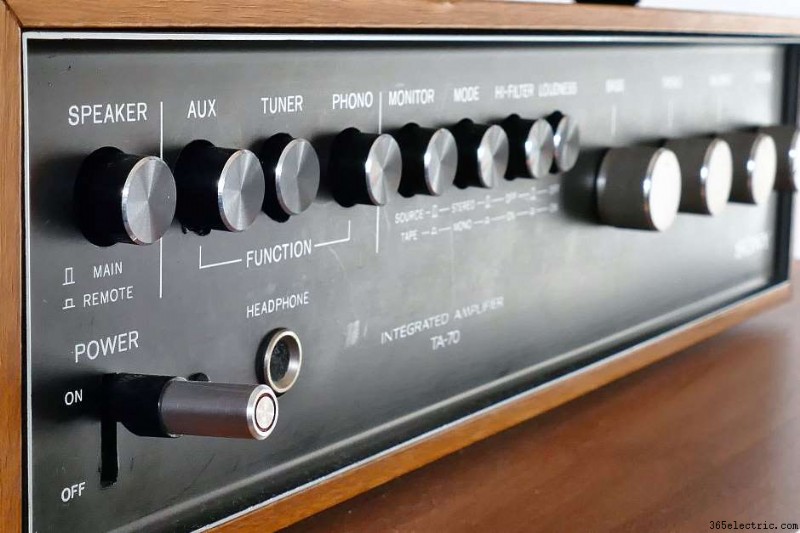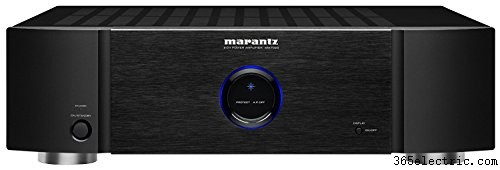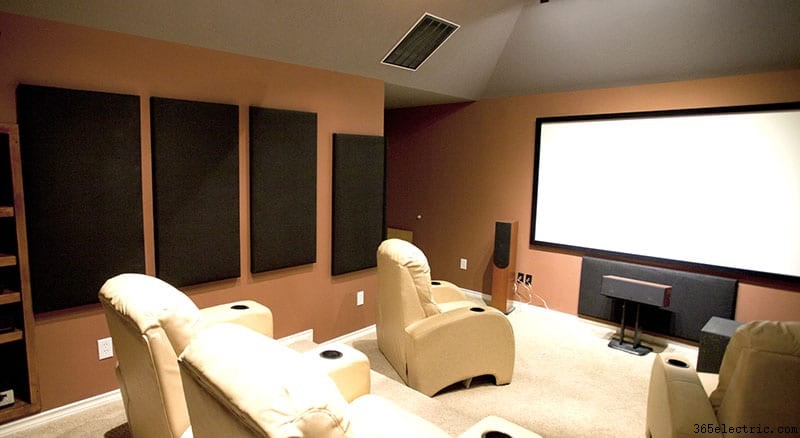O som de qualidade é agradável aos ouvidos, e é por isso que muitos dispositivos incorporados em um sistema de áudio visam produzir um ótimo som. Então, os amplificadores são um dos componentes que tornam o som de áudio tão atraente?
Um amplificador melhora a qualidade do som de várias maneiras. Os amplificadores são feitos fundamentalmente para modular o volume, mas também podem afetar a linearidade e o tom do som. No geral, a qualidade do som depende do tipo de amplificador, configuração, fatores externos como acústica da sala, entre outros fatores. 
Neste artigo, abordaremos alguns tópicos relacionados a essa questão com mais detalhes, incluindo o que é um amplificador e explicando sua função, como funciona um amplificador, os tipos de amplificadores e como vários fatores afetam a qualidade do som. Por fim, há algumas dicas para ajudá-lo a obter um som melhor do seu sistema de áudio.
Definição e funções de um amplificador
Um amplificador (também conhecido informalmente como “amp”) é um dispositivo ou componente eletrônico que aumenta a potência, tensão ou corrente de um sinal.
Ao ser alimentado por uma fonte de alimentação elétrica, um amplificador pega o pequeno sinal elétrico aplicado em seu terminal de entrada, aumenta-o e produz um sinal proporcionalmente maior em seu terminal de saída.
Simplificando, no caso de um amplificador de som, por exemplo, o amplificador recebe o som na extremidade de entrada e produz um som mais alto na extremidade de saída, visando reduzir ao máximo as distorções.
Um amplificador pode ser um dispositivo/equipamento distinto ou um circuito elétrico colocado dentro de outro dispositivo.
Tipos de amplificadores
Os amplificadores podem ser encontrados em quase todos os dispositivos eletrônicos, portanto, existem vários tipos de amplificadores. Existem também várias maneiras de classificá-los.
Com base no tipo de sinal de entrada:tensão, corrente e potência
Existem diferentes sinais que um amplificador pode modular. Se o sinal de entrada estiver em tensão, então o ganho do amplificador é um ganho de tensão produzindo uma tensão mais alta.
Um sinal de entrada de corrente significa que o amplificador produz uma corrente de saída elevada.
Amplificadores também podem produzir potência de saída amplificada como um produto da tensão e corrente da fonte de entrada.
Com base na configuração do circuito e método de operação:Classe A, B, AB e C.
Diferentes tipos de classes de amplificadores de áudio têm configurações de circuitos e métodos de operação variados. Esta classificação diferencia os amplificadores com base em:
- Ganho do amplificador (quanto um sinal é amplificado)
- Linearidade/fidelidade (com que precisão o sinal de saída se assemelha à entrada)
- Níveis de distorção do sinal (quanto o sinal original é alterado)
- Eficiência (quanto desperdício de energia é experimentado durante a amplificação)
Classe A amplificadores são considerados a melhor classe porque eles são provavelmente o melhor som. Eles produzem a melhor linearidade, baixa distorção de sinal e alto ganho. A desvantagem é que eles são grandes, pesados e ineficientes. A sua ineficiência deve-se à sua contínua perda de potência, o que também faz com que produzam muito calor.
Classe B foi projetado para superar as deficiências dos amplificadores classe A. Portanto, os amplificadores classe B são mais baratos, mais eficientes (cerca de 70%) e funcionam mais frios. Infelizmente, eles oferecem baixa linearidade e algum nível de distorção.
Classe AB (como o nome sugere) oferece uma combinação da eficiência da classe B (50-70%) e a grande linearidade da classe A.
Classe C tem a melhor eficiência em torno de 80%, mas a menor linearidade e distorção pesada.
Com todos esses fatores em mente, cada classe de amplificador tem seus prós e contras. Aqui está um resumo de como isso se parece:
| Classe do amplificador | Eficiência aproximada | Prós | Contras |
| A | ~15-35% | Baixa distorção de sinal
Alto ganho | Grande e pesado
Ineficiência =produção de calor |
| B | ~70% | Eficiência relativamente alta | Linharidade ruim
Potencial para distorção de crossover |
| AB | ~50-70% | Mais eficiente que a Classe A
Baixa distorção do sinal | A eficiência é boa, mas não ótima. |
| C | ~80% | Grande eficiência | Mais linearidade
Alto nível de distorção |
Com base no sinal amplificado
Amplificadores de frequência de áudio (amplificadores A.F.): Estes amplificam os sinais de áudio que estão dentro do alcance da audição humana, ou seja, 20 Hz a 20 kHz. Mesmo assim, alguns amplificadores de áudio Hi-Fi podem amplificar sinais de até 100 kHz enquanto outros amplificadores A.F têm um limite superior de 15 kHz. Esses amplificadores são usados para operar alto-falantes.
Amplificadores de frequência intermediária (amplificadores I.F.): Os Amplificadores I.F são usados para amplificar sinais de voltagem de rádio, TV ou radar antes que as informações de áudio ou vídeo transportadas pelo sinal sejam demoduladas.
Amplificadores de radiofrequência (amplificadores R.F.): Amplifique a potência dos sinais de rádio de baixa frequência. Esses amplificadores são amplificadores sintonizados cuja frequência de operação é controlada pelo circuito sintonizado. R.F Amplifiers have low noise performance, and some have little or no gain.
Wideband Amplifiers: These amplifiers are used in devices requiring to measure signals over a wide range of frequencies e.g., oscilloscopes.
Ultrasonic Amplifiers: These amplifiers are a type of audio amplifier. They amplify ultrasonic waves whose frequencies range between 20 kHz and about 100 kHz. They are used in ultrasound scanning, remote control systems, ultrasonic cleaning, etc.
Video Amplifiers: Are a type of wideband amplifier. They amplify video signals, which are signals that carry the picture information on TV, video, and radar systems. The bandwidth varies depending on the use of the video amplifier. For example, for TV sets, it ranges from 0 Hz to 6 MHz, and in radar systems, it’s much wider.
Direct Coupled Amplifiers (DC Amplifiers): Amplify very low-frequency signals like DC (0 Hz) voltages. They are commonly used in measuring instruments and electrical control systems.
Buffer Amplifiers: They have a gain of one, meaning they don’t amplify the signal. Buffer amplifiers are used to isolate circuits from each other so that the operation of one does not affect the operation of the other. They serve as impedance matching devices since their input has a high impedance, while output has a low impedance.
Operational Amplifiers (op-amp): An op-amp is a voltage amplifier with a high gain. It has a differential input and a single-ended output. Op-amps are among the most commonly used electronic devices today. They are used in a number of industrial, consumer, and scientific devices.
How Does an Amplifier Work?

There are three key connections in an amplifier that allows it to function as required:
- A source of power
- An input connection from the signal source (e.g., microphone)
- An output connection to the speaker
The amplifier gets its power supply from the source of power, e.g., a wall socket. The electric current is sent to a valve-like system known as a transistor. The transistor is a variable resistor that controls the amount of current through the circuit based on the signal received from the source through the input connection.
As the input source releases a signal, the transistor lowers its resistance, current flows, the sound is amplified, and a larger signal is sent to the output connection. The larger the input signal, the more the current flows through the circuit hence a greater amplification.
The amplified signal sent to the output connection is what you hear through the speaker as a loud sound.
The amount of amplification is calculated by getting the ratio of the output signal to the input. This is known as the gain of an amplifier. So, for example, a gain of 3 means the amplifier triples the size of the input signal.
For every input amplitude (basically meaning sound volume), an amplifier produces a corresponding increase in output. But amplifiers cannot amplify signals indefinitely.
There’s a range of amplitudes that each amplifier can work on based on its power rating. At its upper limit, the input volume will produce the maximum level of output and no more.
Attempting to deliver an output signal beyond its maximum capacity can result in a phenomenon called clipping. This can increase distortion and, therefore, affect sound quality.
Factors That Affect Sound Quality
Good quality sound is a summation of several factors, and none of those factors can stand in isolation to produce the desired audio quality.
Internal Factors
Every device included in an audio system, for example, impacts the characteristics of sound that will be produced. Whether it’s the microphones, the mixer, the loudspeaker, the cabling, or the amplifier, each of these components needs to be of high quality.
In the case of the amplifier (which is the main focus of this article), the quality varies depending on the brand. Vamos encarar; some brands are just more superior than others and tend to function better. So knowing the best brands will help you get one step closer to having high-quality sound (with all other factors held constant).
The class of the amplifier also matters. As we’ve seen above, different classes have varying amplifier gain, linearity, signal distortion levels, and efficiency. Amplifiers with high linearity produce signal outputs that more accurately resemble the input. And this is one of the aspects of sound quality.
Amplifier gain also varies from one class to another. And this means the amplified sound will be higher for some amplifiers and lower in others.
Based on these factors, class A and AB amplifiers are your best bet when it comes to getting great audio quality.
External Factors
External factors refer to the environment in which one is listening to sound. Here also, you will find that every variable can affect the characteristics of sound. For example the shape of the room, the room size the temperature and humidity levels.
Let’s have a look at the most important external factors that affect sound quality.
Room Acoustics

Room acoustics refers to how sound waves behave in an enclosed space or a listening room.
While people spend a lot of money getting the best sound systems, fewer keep in mind the importance of room acoustics to produce high-quality sound. The items in a room, furniture, and surfaces all have an impact on how your audio will sound when played in that space.
The main concern here is how sound bounces off or is reflected from various objects and surfaces in a room. Different objects at varying distances will reflect sound at different times. These reflections can distort the clarity of sound.
For example, wooden furniture, floors, walls, and glass windows will reflect most of the high-frequency sounds. What is more, some of the hard objects may also vibrate and become a source of noise interfering with the main sound.
On the other hand, soft surfaces like thick, woolen curtains, and floor carpeting can also affect the quality of sound. These surfaces will absorb most low-frequencies resulting in a muffled sound effect.
The solution to all this is creating an acoustic environment with a good balance of absorptive and reflective surfaces. So, if the room has too many reflections, consider adding a floor rug on a hardwood floor or hang up some tapestry on the walls. In a more formal setup, you can get some portable sound absorption panels.
For better understanding, here’s a short video explaining how sound works in rooms
https://www.youtube.com/watch?v=JPYt10zrclQ
Room Size
The size of the room where your sound system is set also affects the quality of sound. The main issue, in this case, is what is termed as reverberation time.
Reverberation time is a measure of how long it takes for sound to fade away or decay. This parameter is expressed as RT60, referring to the time it takes for sound to die off by 60 decibels below the direct sound level. Longer reverberation time affects the quality of sound by superimposing over the original sound you need to hear.
Large spaces with large walls and ceilings create more reflections and result in increased reverberation time. The opposite will be the case for smaller rooms.
All the same, the optimal reverberation time also depends on the purpose of the listening room. For a room or hall intended for music performance, longer reverberation time (2.0 or more seconds) is preferred for good sound quality. While if the room is intended for listening to speeches, or people talking, a lower reverberation time (less than 1.5 seconds) is required.
Another way that room size affects sound quality is the amount of power needed to fill the space with sound. For a big room, a more powerful sound system will be required to be able to fill the room with proper sound. Conversely, listening to audio playing in a smaller room with a less powerful system will sound better than in an expansive space.
Humidity
Humidity is the moisture retention level in the air. Though to a small degree, the humidity levels and temperature of a room can affect the sound quality from a system.
The science of sound reveals that sound requires a medium to travel through. In a listening room, the air is the medium through which the sound travels. Therefore, when the air is humid, it means that there are now two mediums through which sound has to pass:air and water (though not in liquid state).
The impact humidity will have on your audio will depend on the quality of the system you have and the kind of sound. Since humidity affects the density of the atmosphere, it means that the impact will be felt on middle and high-frequency signals because they depend on ray energy. Lower frequency signals are pressure-related and so will not be impacted as much.
So, how will humidity affect the sound? The more humid the air is, the denser the medium for sound to pass through; hence the sound waves will slow down.
Now, though this is a real impact on the sound, the difference is not easily noticeable, especially if there are multiple channels in the room with a lot of energy being produced. Only a very keen ear and one that has already mastered other room acoustics will be able to recognize the impact of humidity on the sound quality.
Tips to Get Better Sound From Your Audio System
So far, we’ve looked at factors that affect your system’s sound quality. So, to better your sound, here is a brief summary of a few tips you can easily implement.
Check Your Gear
Whenever the quality of your sound is not up to your liking, the first thing you should think of is the components of your audio system. Evaluate each of them to find the source of the problem.
Begin with the wires and cables. Are the speakers wired “in phase”? Look into each speaker and watch out for any obvious faults like rotting foam.
If everything looks okay, but the sound quality is still poor, consider upgrading your gear to get high-quality devices.
Work on Your Room Acoustics
If you can get a secluded room for listening to your music, then that’s a plus. You can tweak the room set up to get the best room acoustics.
Temper down on the hard surfaces in the room so that you don’t get too much sound reflections that distort sound quality. “Soften” the room up, but don’t overdo it lest your audio ends up sounding unnatural because of excessive signal absorption.
Position Your Speakers Correctly
Stereo or even multi-channel speakers require an optimal placement to produce excellent sound.
First, ensure your speakers are not standing directly on the floor. Place them on stands. This improves sound fidelity. Also, make sure the speakers are firmly mounted so that there’s minimal possibility of vibrations, which can create unwanted noise. Next, create some distance between the speakers and the rear wall.
Taking time to arrange your room to find the perfect setup for your system. Trial and error is also a strategy to eventually achieve a great sound quality.
Adjust the Sound Settings on Your Receiver/Amplifier
The menu system on most stereo receivers/ amplifiers allows the user to make adjustments on different features and sound functions. Pay attention to the bass output, speaker size, and speaker volume. These are the most important in creating your preferred sound.
Conclusão
While an amplifier’s main job is to boost signals, it can also affect the quality of sound, e.g., the accuracy of its output in relation to the input signal (i.e., the fidelity) and how much it eliminates distortion.
Even so, the quality of sound from any audio system is not only dependent on the amplifier but also every other component making up the system and the external factors in which the audio is played. All these factors, when well optimized, can result in high-quality sound according to the user’s preference.


